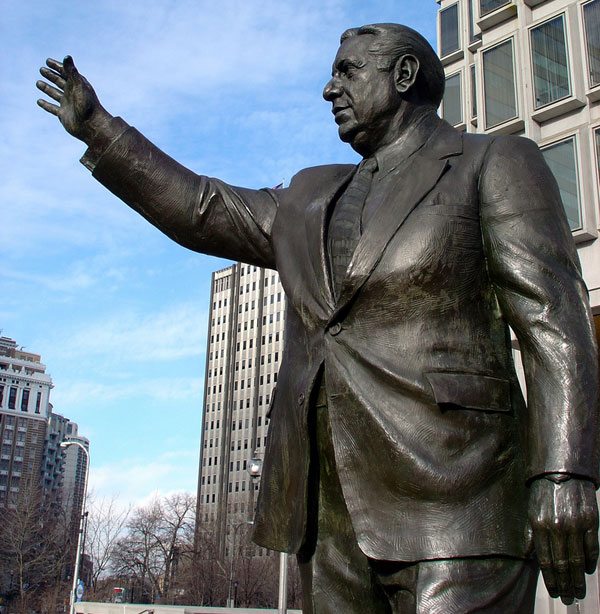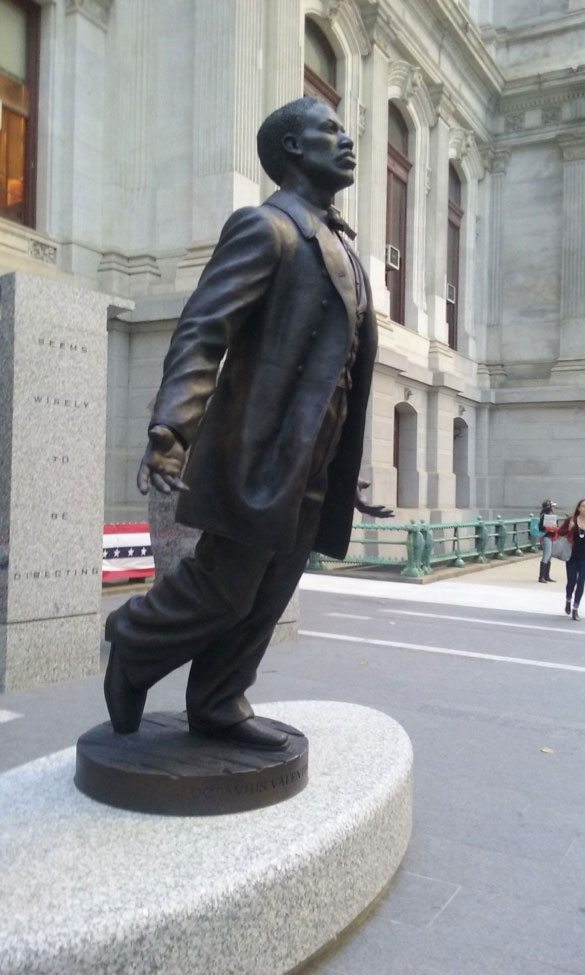
September 27, 2017; Next City
Although controversy has for some time been swirling around statues in U.S. cities—particularly in the South—that represent Confederate leaders, the violence that erupted in Charlottesville last month accelerated dialogue, and in some cases led to decisive action. Philadelphia, which, as Next City notes, was never part of the Confederacy, nevertheless jumped into the fray as civic leaders seized the moment to ask (not for the first time) if a towering bronze likeness of former mayor Frank Rizzo, whose complex legacy as a police officer and then commissioner at a time of intense racial tension, ought to remain on public property. Even as that question continues to simmer, two distinct, long-planned Philadelphia monument projects serendipitously went public this month:
- Monument Lab: A Public Art and History Project, a concept developed by Mural Arts Philadelphia over the last five years, has installed what the website describes as “prototype monuments by 20 artists across 10 sites in Philadelphia’s iconic public squares and neighborhood parks.” At the heart of the project is this question: “What is an appropriate monument for the current city of Philadelphia?” The answers offered by the artists vary greatly, and invite public commentary.
- On Tuesday, the city unveiled a monument—right beside City Hall—of the 19th-century black activist Octavius Valentine Catto. As noted in the Next City article, “Philadelphia has more public art than any other city in the U.S., and yet until Tuesday, there was no public statue of a sole black person on any piece of public land in the city.” The unveiling ceremony was described as “an out-and-out urban pageant,” with hundreds of attendees crowded into the concrete apron surrounding City Hall.

Philadelphia, it seems, is having a monumental moment.
As the website for Monument Lab explains:
Philadelphia is a city full of monuments and memorials. Philadelphia is also a city full of monumental histories, many of which are little known, obscured, or simply unacknowledged. These underrepresented histories often exist in tension with officially acknowledged narratives. The projects that make up Monument Lab address issues of social justice and solidarity, including matters of race, gender, sexuality, class, and national belonging. The monuments proposed through this exhibition are made of stone and bronze, as well as recycled materials, images, sounds, and the byproducts of community process.
Sign up for our free newsletters
Subscribe to NPQ's newsletters to have our top stories delivered directly to your inbox.
By signing up, you agree to our privacy policy and terms of use, and to receive messages from NPQ and our partners.
The monument to Catto, who was an educator, an athlete, and an organizer who helped to desegregate the city’s streetcars and pushed for equal voting rights for blacks, has been talked about for decades. It was finally realized in part because former city councilman and current mayor Jim Kenney spearheaded a 15-year-long campaign to memorialize the largely forgotten activist. Catto was shot to death in 1871 at the age of 32 by a white Irish Catholic on the first election day after the 15th amendment was passed, giving black men the right to vote. Kenney, who is also Irish Catholic, called Catto “a true American hero” at the ceremony on Tuesday. In one report on the monument’s unveiling, Kenney is quoted as saying, “We know more about Rocky [Balboa]—who’s not even a real person—than we know about Octavius, which says a lot.”
Kenney also said this of Catto:
Like many other unknown and nameless black American heroes, he should be revered, honored and recognized. Their lives and accomplishments should be part of the daily curriculum in our schools, not just during the shortest month of the year…My hope is that someday, every child in Philadelphia will know as much about Octavius Valentine Catto as they do about Benjamin Franklin, George Washington and Dr. Martin Luther King, Jr.
While the Catto monument is completely separate from the Monument Lab project, it is now part of a fascinating trio of public art pieces within the immediate vicinity of City Hall, which are, in a very real sense, in dialogue with each other—at least for now—and among the city’s liveliest photo and selfie sites:
- Catto stands tall on the south side of City Hall—with an elegant interpretation of a ballot box in front of him and a series of engraved pillars, representing a streetcar and highlighting his many contributions, behind him, as rendered by sculptor Branly Cadet, who helped Kenney unveil his work.
- On the north side, just across the street and in front of the Municipal Services Building, is the statue of two-term mayor Rizzo, which in the immediate aftermath of Charlottesville was egged and then spray-painted with graffiti but was quickly cleaned up. The fate of this statue now rests with the city’s Art Commission—although Kenney also asked the public to weigh in on whether the statue should stay where it is (perhaps with a new marker that provides additional context), be taken out of public view, or be relocated so that it no longer stands on public land. The Art Commission could announce its decision next month.
- Within a few yards of Rizzo, one of the Monument Lab pieces has been placed, provocatively, in the wake of the violence in Charlottesville and the August rumblings about the Rizzo memorial. The piece, “All Power to All People,” is a 12-foot-tall, 800-pound Afro pick, the top of which is a Black Power fist, created by artist Hank Willis Thomas. As noted in Next City, Rizzo’s “police force notoriously strip-searched a group of Black Panthers in front of newspaper cameras in 1970.”

The Monument Lab projects are on display through November 19th, so whether Rizzo stays or goes, the juxtaposition with Thomas’s work is only temporary. But Octavius Valentine Catto—he has at last taken up his rightful place in the shadow of City Hall, and it looks like he’s there to stay.—Eileen Cunniffe













